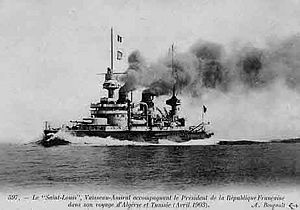French battleship St Louis (1896)
 The St Louis in April 1903 | |
| Career (France) | |
|---|---|
| Namesake: | Louis IX of France |
| Owner: | France |
| Builder: | Lorient shipyard |
| Laid down: | 1893 |
| Launched: | 1896 |
| Commissioned: | September 1900 |
| Struck: | 1933 |
| Fate: | Broken up |
| General characteristics | |
| Class and type: | Charlemagne class battleship |
| Displacement: | 11,300 tonnes |
| Length: | 118 m |
| Beam: | 20.5 m |
| Draught: | 8.40 m |
| Propulsion: | 2 steam engines, 3 shafts, 14,500 HP |
| Speed: | 18 knots |
| Complement: | 694 men |
| Armament: |
2 × 2 - 305 mm Mle 1893/96 guns |
| Armour: |
belt : 250-400 mm |
The Saint Louis was a pre-dreadnought capital battleship of the French Navy. She was laid down in 1893, launched in 1896, and completed in 1900 as the third battleship of her class, the Charlemagne class. The ship saw service in the First World War, and was scrapped in 1933.
Design
The St Louis displaced 11,300 tonnes (11,100 long tons), was 118 metres (387 ft) long, had a beam of 20.5 metres (67 ft) and a draught of 8.4 metres (28 ft). She was manned by 694 men.[1] Equipped with a set of two steam engines rated at 14,500 indicated horsepower (10,800 kW), the St Louis could move at a maximum speed of 18 knots (33 km/h; 21 mph).[1] She was one of the first French ships to be armed with twin mounted main guns, although the armament was eventually deemed too heavy for the ship's displacement.[1] Those were four 305 mm Mle 1893/96 guns.[2] The main battery was augmented by a secondary battery of ten single 138 millimetres (5.4 in) guns and a tertiary battery of eight 100 millimetres (3.9 in). The ship was also armed with four 450 millimetres (18 in) torpedo tubes.[1][2]
Service history
After commissioning, the St. Louis was sent off on several cruises with the Third Battleship Squadron. On one of these, she accidentally rammed the French submarine Vendémiaire, killing 23,[3] although other sources state that 25 men drowned.[4] In the First World War, she was sent off to participate in the Naval operations in the Dardanelles Campaign, where she was held in reserve while her sisterships, the Charlemagne and Gaulois, bombarded Ottoman ports.[5] After the First World War, the ship returned to a normal peacetime naval atmosphere involving naval exercises and cruising in the Mediterranean sea. She was scrapped in 1933, one of the longest-surviving pre-dreadnoughts to remain in service.[1][5]
References
- ↑ 1.0 1.1 1.2 1.3 1.4 "St Louis French Battleship". www.battleships-cruisers.co.uk. http://www.battleships-cruisers.co.uk/st_louis.htm. Retrieved 4 June 2010.
- ↑ 2.0 2.1 Jackson 2000, p. 153.
- ↑ United States Naval Institute 1912, p. 1114.
- ↑ Chisholm 1913, p. ?
- ↑ 5.0 5.1 "French Navy in World War I in Outline". Naval History Homepage. http://www.naval-history.net/WW1NavyFrench.htm. Retrieved 4 June 2010.
Bibliography
- Chisholm, Hugh (1913). The Britannica Year-book 1913. Encyclopaedia Britannica. http://books.google.com/books?id=sQRVSVR1fLsC&pg=PR29&dq=battleship+st+louis&cd=5#v=onepage&q=battleship%20st%20louis&f=false.
- Jackson, Robert (2000). The World's Greatest Battleships. Singapore: Greenwich Editions.
- United States Naval Institute Proceedings, Volume 38. United States Naval Institute. 1912. http://books.google.com/books?id=ZZzJoYNBHEEC&pg=PA1114&dq=battleship+st+louis&cd=2#v=onepage&q=battleship%20st%20louis&f=false.
